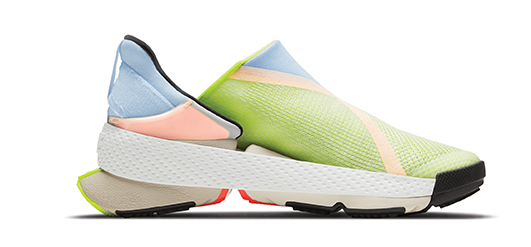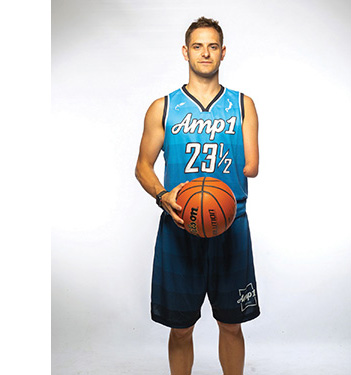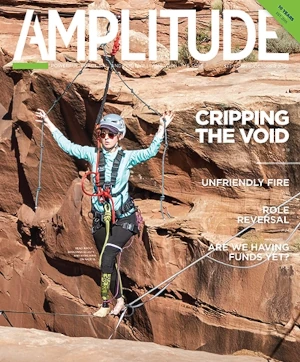Two limb-different employees helped develop a transformative Nike product line—and flipped the paradigm on inclusive design.
by Larry Borowsky
When it comes to generating buzz for new products, Nike is in a class by itself. The company put on a clinic last February during the media blitz for the GO FlyEase, widely acclaimed as the world’s first hands-free shoe. Forbes wrote that FlyEase brought “the end-to-end luxury brand experience to people experiencing disabilities.” Wired credited Nike with “reinventing how we wear shoes entirely.” Time included the shoe on its list of top inventions for 2021. And Teen Vogue’s headline swooned: “Nike’s GO FlyEase Are Cool. The Inspiration Is Cooler.”
The inspiration in question dates to 2012, when Matthew Walzer, a Florida high schooler with cerebral palsy, penned an open letter to Nike CEO Mike Parker. “Out of all the challenges I have overcome in my life, there is one that I am still trying to master: tying my shoes,” Walzer wrote. “My dream is to go to the college of my choice without having to worry about someone coming to tie my shoes every day.”

The letter went viral, prompting Parker to tap Nike’s longtime innovation guru, Tobie Hatfield, to devise a custom solution for Walzer. When the young man moved into his university dorm a couple of years later, Walzer had a pair of personalized kicks he could don and doff himself—and Nike had the seeds of a new adaptive product line.
It also had a creation myth that was feel-good gold, and the company has mined that vein ever since. As the FlyEase product line unfolded throughout the late 2010s, Walzer became legendary as Nike’s prophet of inclusive design, a co-visionary in a revolutionary project.
It’s an irresistible narrative, and it’s largely true, but it actually sells the story short. Here’s the part it leaves out: Nike employees with disabilities—including two amputees—played indispensable roles in shepherding FlyEase from one-off invention to niche product to full-fledged brand platform. These professionals shaped everything from FlyEase’s technical specs to its functionality, visual design, and marketing message. In the process, they exerted a level of influence that’s rarely achieved by disabled workers in corporate America.
“When you are able to create a product without having to put yourself in someone else’s shoes, it tends to make things a bit easier or a bit more digestible,” says Richard Ramsay, who joined the FlyEase project shortly after Walzer’s letter started making the rounds on Nike’s campus. A congenital arm amputee with a degree in kinesiology and a standout athletic resume, Ramsay combined the technical know-how of a fitness expert with the cultural perspective of an adaptive consumer. “I didn’t have to put myself in the shoes of someone who only has the use of one hand,” he says. “I’ve lived that way my entire life.”
Nike’s experiment with disability-led design illustrates how all consumers stand to gain when people with disabilities are invited to the decision-making table. It also flipped the paradigm for inclusive products: Instead of being created by able-bodied designers for adaptive end users, FlyEase was conceived by people with disabilities to serve bodies of every type.
“We’re not designing just for the disability population,” says Sarah Reinertsen, an above-knee amputee who collaborates with Ramsay on the FlyEase product line. “We’re designing shoes that work for everybody.”
MATTHEW WALZER’S PLEA TO NIKE hit very close to home for Ramsay. He, too, had to navigate his awkward teens while conspicuously needing help with his high tops.
“I remember being a 13-year-old boy, and my dad having to run down to the court during basketball games when my shoes came untied,” says Ramsay. “I don’t love to be the center of attention. But when you’re in junior high and early high school, and you’re putting your foot up your dad’s knee during a dead ball so he can tie your shoes for you, you’re pretty center of attention.”

Richard Ramsay
For the most part, though, Ramsay attracted the spotlight with his running, dribbling, and shooting. He starred in multiple high school sports, playing with and against able-bodied players, and remained a relentless gym rat throughout college. After graduating from Arizona State in 2010, Ramsay joined AMP1, a stand-up amputee basketball team whose roster includes players with both upper- and lower-limb difference. It was the first time he had spent much time around athletes who compete on prosthetic legs, and that opened his eyes to whole new set of adaptations—and a whole new set of failures in conventional athletic gear.
“I would watch my teammates pull out their shoehorn and struggle to shove their foot into the shoe without having any mobility in the ankle,” Ramsay says. “I started thinking, ‘How can we make that easier so they can put their basketball shoes on faster and not have to show up to the gym an hour early just to get their legs ready?’”
He started mentally jotting down notes about how to make footwear that was more functional for adaptive athletes. As a newly minted Nike hire (he joined the company’s footwear development branch in mid-2012), he knew just the person to share these ideas with: Tobie Hatfield. Though Ramsay stood innumerable tiers below Hatfield in the Nike org chart, he finagled an introduction through a friend of a friend. Once he got in front of his target, Ramsay held nothing back.
“I started telling Tobie about all these crazy ideas I had for making shoes for amputees,” he laughs. “I was basically quizzing him about how I could make some of these things happen.”
As it turned out, his fool’s errand was perfectly timed: In the wake of Walzer’s letter, Nike executives were already discussing the pros and cons of breaking into the adaptive market. Hatfield politely listened to Ramsay’s monologue and sent him on his way. Months went by without any follow-up. Ramsay carried on with his regular duties on one of Nike’s running shoe lines.
Then he got an unexpected email. Hatfield had a pair of sneakers he wanted Ramsay to try on.
CONNOISSEURS OF NIKE LORE KNOW that Walzer’s shoes weren’t developed entirely from scratch. They built on concepts that first appeared in 2004, when Jeff Johnson, a lifelong runner who wore Employee Badge #1 at Nike—literally the company’s first hire—suffered a stroke that paralyzed the right side of his body. To aid Johnson’s recovery, the company cooked up some running shoes that he could strap on with one hand. Eight years later, when Hatfield started working on an answer to Walzer’s Hail Mary, he dusted off the Johnson sketches as his baseline.
It was still a pretty rudimentary starting point. Although these things happened less than ten years ago, it might as well have been the Dark Ages where adaptive apparel is concerned. The market as we know it today didn’t exist: There was no Runway of Dreams Foundation, no Tommy Adaptive, no accessible Cat & Jack. Mass-market brands at that time paid only grudging attention to plus-size bodies, much less bodies with nonconforming skeletal or neuromuscular traits.
“You can’t design for someone you don’t see,” says Stephanie Thomas, one of the few fashion-industry professionals who was focused on accessibility at the time Nike FlyEase was hatched. “And you can’t see someone that you don’t value as a customer.”
The customer value of people with disabilities was just beginning to dawn on major retailers at the time Walzer reached out to Nike. Companies such as Hilfiger, Zappos, and Target were starting to nose around in the adaptive sector. But nobody had written a playbook yet for designing, manufacturing, and marketing inclusive apparel at scale.

his custom Nikes.
“That was actually one of the beautiful things about it,” Ramsay says. “When there’s no template to follow, you can create your own. But it’s a little bit of a double-edged sword, because when there is no process laid out in front of you, you also run into the challenges of: ‘How do we do this? It’s never been done before.’”
When he answered Tobie Hatfield’s summons, Ramsay became perhaps the first amputee to wear the shoes that would eventually become FlyEase. They featured a zip-up heel that allowed the foot to slip in and out easily, along with a pullover strap to tighten the fit. They paired convenient one-handed operation with the athletic look and feel of Nike’s standard product line. As he took his first steps in the FlyEase-to-be, Ramsay felt a flood of relief and excitement.
“It was this overwhelming feeling,” he says. “I don’t know the best way to explain it. It was just this realization that if I’d had a shoe like this growing up, I wouldn’t have had to go through a lot of embarrassment and bad feelings. So I knew we were going to be able to change things for a lot of people and remove the Othering that I had to go through.”
Hatfield asked for some specific feedback, and he and Ramsay started tossing around ideas, rapid-fire. “I started asking, ‘What if you tried this?’ or ‘Have you tried doing that?’ We riffed for probably an hour and a half. And that was the start of a forever friendship with Tobie.”
The conversation continued for more than a year. Nike’s core project team for FlyEase comprised just three people: Hatfield, Ramsay, and innovator Sarah Sowers (who Ramsay describes as the business brains of the group). Walzer, by then a college student at Florida Gulf Coast University, stayed involved as a muse and beta-tester. After a pilot run of roughly 6,000 pairs sold out in early 2015, Nike introduced the new product to the world in July 2015 with the release of the Zoom Soldier 8 FlyEase—an adaptive version of the company’s signature LeBron James basketball shoe. Photos of a beaming Walzer arm in arm with LeBron, his hoops hero, enjoyed wide circulation. Nike’s first adaptive product was airborne.
ALMOST IMMEDIATELY, FLYEASE CAUGHT ON among consumers far beyond the disability community. Parents saw the adaptive shoe as an easy-on/easy-off option for their kids, so Nike hustled children’s sizes into the stores. Soon thereafter the company integrated FlyEase technology into its running, core performance, and price-conscious categories. Shoppers clamored for more color options, a broader range of sizes, and additional features. The FlyEase innovation team expanded to more than half a dozen people, but they still struggled to keep up with the demand for new variations. Limb-different NFL player Shaquem Griffin and WNBA superstar Elena Delle Donna (whose sister has cerebral palsy) got behind their own FlyEase iterations, raising the brand’s profile still further.
Even as FlyEase’s appeal grew among able-bodied consumers, people with disabilities continued to drive the product’s evolution inside the company. Reinertsen joined the design team in 2018, bringing years of experience in product development to bear. A former Paralympian and record-setting paratriathlete, Reinertsen had previously consulted with Hatfield on Nike Sole, which paired with Össur’s Flex-Foot running blade to give athletes better traction and faster times. When Hatfield and Ramsay began working on FlyEase a year or two later, they brought in Reinertsen as a tester and sounding board until she ultimately made it her full-time gig.

Sarah Reinertsen
“Nike Sole was an impactful innovation,” Reinertsen says, “but I’m more excited about FlyEase because of its transferability potential. It not only serves a market of people with disabilities or physical difference, but is equally appealing and valuable to the so-called able-bodied population. If I can make it easy for a person with no hands or one finger to get their shoes on, then I’m making it easier for anybody.”
And what could be easier than a fully hands-free shoe? That was the outcome they targeted when GO FlyEase hit the drawing board in about 2018. It required a complete re-think. From a functional perspective, GO FlyEase eliminated single-hand features like zippers and straps and replaced them with a novel foot-activated mechanism. But it also reflected a philosophical shift from inclusive design to something broader: universal design.
“This shoe might be for people who we would define as disabled,” says Ramsay. “But it could also be for people who have arthritis, or they have a back injury and can’t bend over, or their dexterity is limited because they’re aging.”
“We like to say that everybody is temporarily able-bodied,” adds Reinertsen. “You might join the disability community for a period of time if you’ve broken your wrist or had surgery or something else. And there are people who have disabilities that you can’t see. They’re also incredibly important in this process.”
The transition from inclusive to universal design was so firmly embedded in GO FlyEase that the product’s rollout last February brought some blowback from some parts of the disability community. “Why Won’t Nike Use the Word Disabled to Promote Its New GO FlyEase Shoe?” asked one headline. Another accused Nike of “using disability” to hype its shoe. And still other voices warned that the corporate giants stampeding into the adaptive clothing industry would trample small, innovative startups that are more committed to disability and inclusion than to profits.
Fashion stylist Stephanie Thomas doesn’t share those concerns. The founder of Cur8able Disability Fashion and a congenital amputee, Thomas is one of the most prominent figures in the adaptive fashion industry. She believes the presence of corporations like Nike has a normalizing effect that helps all players in the disability marketplace, including niche firms.
“It’s not a popular opinion,” she says, “but we have to have the larger brands involved. The idea is to shift the culture. [Large manufacturers] have the money, and they have the machine. And I don’t want them treating us any differently than they would treat any other consumer. But I don’t want them to remove disability from the conversation completely; I do want them to design with disability at the beginning of the process. Because disability equals innovation.”
“We are just scratching the surface when it comes to universal design,” says Ramsay, who won a coveted Nike Maxim Award in 2016 for his role on FlyEase. “I think universally designed products are going to increase exponentially, but it’s going to be far greater than just the product side. In the past year and half, [disabled] people who may never have been able to commute to work can now work at home. We can now do things we’ve never been able to do, which opens up opportunities for both companies and employees. We’re now more connected than ever. We’re more aware of certain things than ever. We are probably smarter than ever. That in and of itself is going to take universal design to a new place.”
“We’ve got a ways to go,” Ramsay says, “but we know which way to go. So this is a beautiful time.”
More Amplitude articles about inclusive fashion and universal design
“Fashion Forward,” July/August 2020
“Five Amputee Models in Runway of Dreams’ NYFW Show,” September 8, 2021
“Jeans for Amputees, by an Amputee,” May 12, 2021
“Amputee Clothing Gets a Lift from Uniteable,” March 3, 2021
“Adaptista Raises the Bar on Inclusive Fashion,” February 23, 2021
“Ready to Wear: Amputee Fashion Tips,” July 29, 2020



